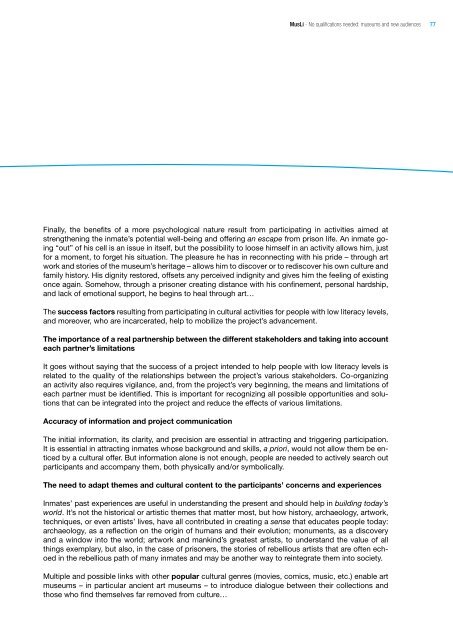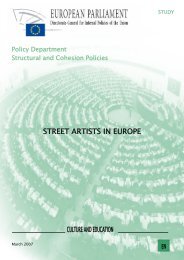MusLi (Museums Literacy) - Fondazione Fitzcarraldo
MusLi (Museums Literacy) - Fondazione Fitzcarraldo
MusLi (Museums Literacy) - Fondazione Fitzcarraldo
Create successful ePaper yourself
Turn your PDF publications into a flip-book with our unique Google optimized e-Paper software.
<strong>MusLi</strong> - No qualifications needed: museums and new audiences<br />
Finally, the benefits of a more psychological nature result from participating in activities aimed at<br />
strengthening the inmate’s potential well-being and offering an escape from prison life. An inmate going<br />
“out” of his cell is an issue in itself, but the possibility to loose himself in an activity allows him, just<br />
for a moment, to forget his situation. The pleasure he has in reconnecting with his pride – through art<br />
work and stories of the museum’s heritage – allows him to discover or to rediscover his own culture and<br />
family history. His dignity restored, offsets any perceived indignity and gives him the feeling of existing<br />
once again. Somehow, through a prisoner creating distance with his confinement, personal hardship,<br />
and lack of emotional support, he begins to heal through art…<br />
The success factors resulting from participating in cultural activities for people with low literacy levels,<br />
and moreover, who are incarcerated, help to mobilize the project’s advancement.<br />
The importance of a real partnership between the different stakeholders and taking into account<br />
each partner’s limitations<br />
It goes without saying that the success of a project intended to help people with low literacy levels is<br />
related to the quality of the relationships between the project’s various stakeholders. Co-organizing<br />
an activity also requires vigilance, and, from the project’s very beginning, the means and limitations of<br />
each partner must be identified. This is important for recognizing all possible opportunities and solutions<br />
that can be integrated into the project and reduce the effects of various limitations.<br />
Accuracy of information and project communication<br />
The initial information, its clarity, and precision are essential in attracting and triggering participation.<br />
It is essential in attracting inmates whose background and skills, a priori, would not allow them be enticed<br />
by a cultural offer. But information alone is not enough, people are needed to actively search out<br />
participants and accompany them, both physically and/or symbolically.<br />
The need to adapt themes and cultural content to the participants’ concerns and experiences<br />
Inmates’ past experiences are useful in understanding the present and should help in building today’s<br />
world. It’s not the historical or artistic themes that matter most, but how history, archaeology, artwork,<br />
techniques, or even artists’ lives, have all contributed in creating a sense that educates people today:<br />
archaeology, as a reflection on the origin of humans and their evolution; monuments, as a discovery<br />
and a window into the world; artwork and mankind’s greatest artists, to understand the value of all<br />
things exemplary, but also, in the case of prisoners, the stories of rebellious artists that are often echoed<br />
in the rebellious path of many inmates and may be another way to reintegrate them into society.<br />
Multiple and possible links with other popular cultural genres (movies, comics, music, etc.) enable art<br />
museums – in particular ancient art museums – to introduce dialogue between their collections and<br />
those who find themselves far removed from culture…<br />
77






